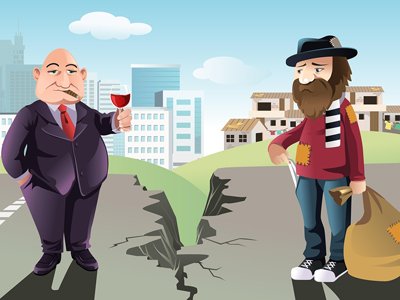Cancer can strike anyone, rich or poor, but not necessarily equally. It turns out, the size of your bank account may be an important factor in determining what type of malignancy you are likely to develop…and how likely you are to die from it. According to new research, certain cancers are much more common in people with low incomes and others are much more common in people with higher incomes.
The study, which was conducted at the Rutgers School of Public Health in New Brunswick, New Jersey, found that there is a disparity between the forms of cancer typically diagnosed in wealthy individuals versus the forms typically diagnosed in poor individuals.1 Reinberg, Steven. “Income Might Influence Risk for Certain Cancers.” WebMD. 27 May 2014. Accessed 1 June 2014. http://www.webmd.com/cancer/news/20140527/your-income-might-influence-your-risk-for-certain-cancers The scientists pored over United States Census data covering 16 states and Los Angeles County. This helped them obtain information on the poverty rates throughout a large enough swath of the country that it included 42 percent of the national population. Simultaneously, they determined that there were nearly three million cancer patients within these areas.
Surprisingly, the researchers found that the places with the highest poverty levels had generally fewer cancer diagnoses than did areas with much greater wealth. However, and perhaps not so surprisingly, the mortality rate from cancer was notably higher in poorer regions. It has been suggested this means that maybe it is not that the poor get cancer less often, but that they are not diagnosed until later stages. Not being diagnosed as early would certainly account for the higher mortality rate, but it doesn’t account for the fact that, ultimately, the poor get fewer cancers. Lifestyle would likely play a role there. And this would be supported by the fact that of the 39 forms of cancer identified in the research, 32 of them have occurrence rates that vary by economic distribution. Eighteen of the 32 are less frequently found in poorer neighborhoods, while the remaining 14 are more frequently found where the poverty level is higher.
Some of the cancers more prevalent in impoverished locales included cervical cancer, laryngeal cancer, penile cancer, liver cancer, and Kaposi sarcoma, which is a cancer of the epithelial cells of the blood and lymph vessels that often strikes those with AIDS. Several of these cancers are linked to lifestyle choices associated with impoverished areas such as heavy alcohol use, smoking, use of recreational drugs by injection, and poor nutrition. In addition, some of these cancers may result as a complication of a sexually transmitted disease, which may signify that adequate protection is not necessarily regularly taken among less affluent populations. Plus, Kaposi sarcoma is mainly found in those with HIV or AIDS because it generally only develops in people with an already weakened immune system. And, according to a 2014 study by the Centers for Disease Control and Prevention in Atlanta, the prevalence rate of HIV is more than 20 times higher in heterosexuals living in urban poverty than it is among those living above the poverty threshold.2 Denning, Paul and DiNenno, Elizabeth. “Communities in Crisis: Is There a Generalized HIV Epidemic in Impoverished Urban Areas of the United States?” Centers for Disease Control and Prevention. 10 January 2014. Accessed 2 June 2014. http://www.cdc.gov/hiv/risk/other/poverty.html
The affluent, on the other hand, appear to be more prone to a different group of cancers, including thyroid cancer, testicular cancer, breast cancer, prostate cancer, and skin cancers such as melanoma. The scientists’ explanation for the higher rates of these diseases focuses on the fact that they are mainly types of cancer that are diagnosed through the use of technological advancements that are typically more available to wealthier individuals than to poorer ones. But again, that argument only accounts for the higher mortality levels amongst the poor. Yes, you’re more likely to die from breast cancer and prostate cancer if it’s not diagnosed as early, but you’re still going to be diagnosed with it when you die. Something else is going on here. Perhaps, wealthier people live lifestyles and in areas that expose them to different toxins. Or perhaps it’s just a question of sociodemographics grouping people with similar genetic risk factors in the same area.3 Clarke CA1, Glaser SL, West DW, Ereman RR, et al. “Breast cancer incidence and mortality trends in an affluent population: Marin County, California, USA, 1990-1999.” Breast Cancer Res. 2002;4(6):R13. http://www.ncbi.nlm.nih.gov/pmc/articles/PMC314435/ Then again, disparities in insurance, often higher stress levels, and more common negative health habits also may factor into the development of cancer. And when all is said and done, a Social Security Administration study from 2007 found that higher income may result in greater longevity in general.4 Waldron, Hilary. “Trends in Mortality Differentials and Life Expectancy for Male Social Security-Covered Workers, by Average Relative Earnings.” U.S. Social Security Administration. October 2007. Accessed 2 June 2014. http://www.ssa.gov/policy/docs/workingpapers/wp108.html
The bottom line is that, no matter what your paycheck says, there are steps you can take to lead a healthier lifestyle and lower your risk of developing any kind of cancer. Quitting smoking and cutting back on alcohol use help reduce the risk of many cancers as well as a number of other diseases. Eating a low-calorie diet based on natural foods will not only provide your body with the essential nutrition it needs, but will help you lose excess fat, which has been linked in many studies with cancer, heart disease, and diabetes. Yet another important part of the puzzle is exercise, which should be part of your daily routine. Visit your doctor on a regular basis for cancer screenings, especially if you have an elevated risk for a particular type, such as skin cancer. If you are willing to make a few adjustments to your daily habits, you can make a tremendous difference in your health in years to come.
References
| ↑1 | Reinberg, Steven. “Income Might Influence Risk for Certain Cancers.” WebMD. 27 May 2014. Accessed 1 June 2014. http://www.webmd.com/cancer/news/20140527/your-income-might-influence-your-risk-for-certain-cancers |
|---|---|
| ↑2 | Denning, Paul and DiNenno, Elizabeth. “Communities in Crisis: Is There a Generalized HIV Epidemic in Impoverished Urban Areas of the United States?” Centers for Disease Control and Prevention. 10 January 2014. Accessed 2 June 2014. http://www.cdc.gov/hiv/risk/other/poverty.html |
| ↑3 | Clarke CA1, Glaser SL, West DW, Ereman RR, et al. “Breast cancer incidence and mortality trends in an affluent population: Marin County, California, USA, 1990-1999.” Breast Cancer Res. 2002;4(6):R13. http://www.ncbi.nlm.nih.gov/pmc/articles/PMC314435/ |
| ↑4 | Waldron, Hilary. “Trends in Mortality Differentials and Life Expectancy for Male Social Security-Covered Workers, by Average Relative Earnings.” U.S. Social Security Administration. October 2007. Accessed 2 June 2014. http://www.ssa.gov/policy/docs/workingpapers/wp108.html |











